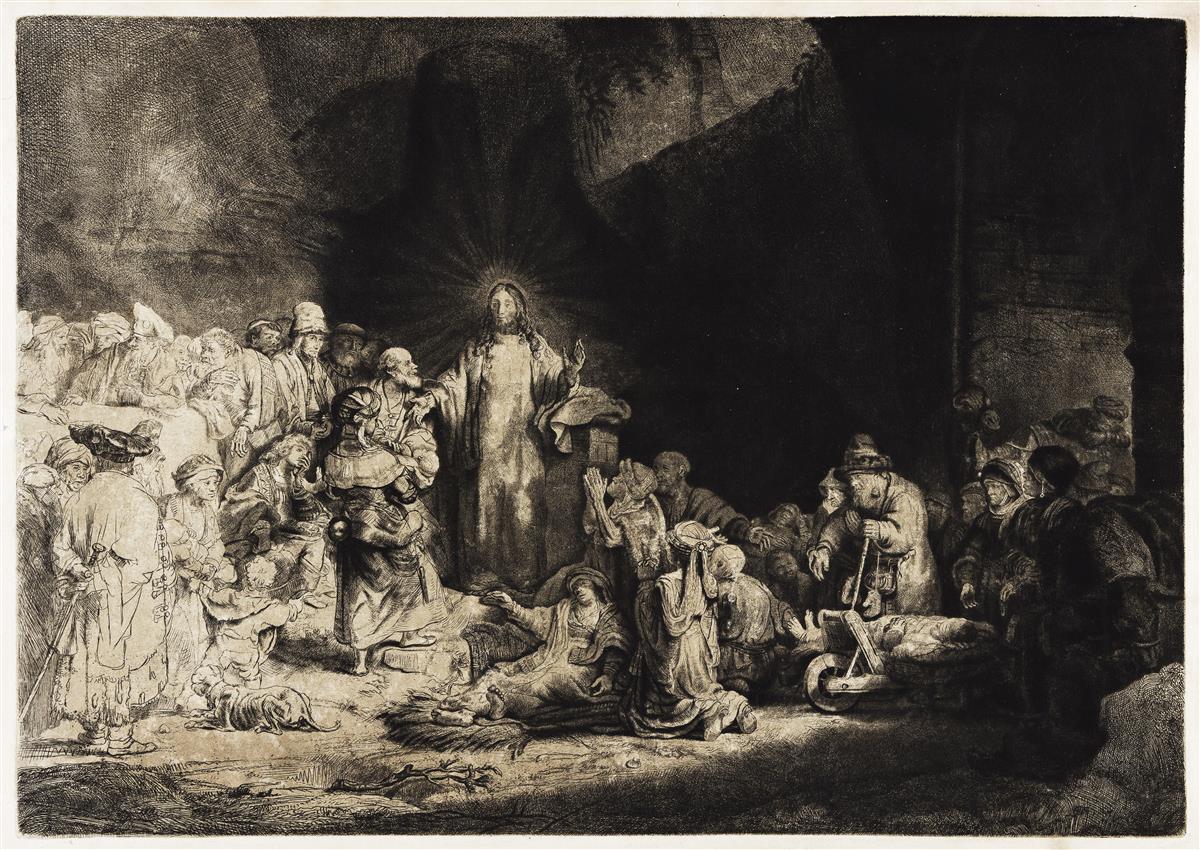Sale 2602 - Lot 124
Unsold
Estimate: $ 30,000 - $ 50,000
REMBRANDT VAN RIJN
Christ Receiving the Children and Healing the Sick (The Hundred Guilder Print).
Etching, engraving and drypoint, circa 1648. 279x388 mm; 11 1/4x15 1/4 inches, small margins. Biörklund's second state (of 2), with the Baillie rework; Usticke's fifth state (of 5); White and Boon's second state (of 2); New Hollstein's third state (of 4); before the plate was cut into several pieces by Baillie. Strasburg Lily (?) watermark (Ash/Fletcher 36). A very good, dark and richly-inked impression of this large, scarce, important etching, with burr on the head and back of the woman holding the baby before Christ's outstretched right arm.
The original copper plate for this etching was owned by a Dutch collector after Rembrandt's (1606-1669) death and was sold to the American artist John Greenwood (1727-1792) around 1775. Greenwood originally worked in Boston and during the early 1770s relocated to London, where in addition to continuing to practice as a portrait painter and engraver, he became a successful art dealer. He owned The Hundred Guilder Print plate for just a short time, selling it to Captain William Baillie (1723-1810), an officer in the English army and a professional printmaker, who after acquiring the plate, reworked it and issued an "edition" of some 100 impressions before ultimately cutting up the plate, and further printing impressions from four different pieces of the plate.
According to a summary of this important etching by Luijten, "That it is known in only two 17th century states, with the minor difference between them of additional shading over the neck of the donkey on the right and the far wall of the archway, belies the exceptional effort that the plate represents in terms of imaginative power, technical brilliance and pictorial finish. Rembrandt applies every tool at his command and in a variety of styles, from the freely outlined Pharisees in debate on the left, flooded in light, to the precise rendering of the textures that apparel the figures who enter from the right. All the groups are subjugated to the overriding chiaroscuro, which ranges from the deep blacks into which Christ's halo melts away, to the areas left white which suggest a sudden source of startling illumination. The play of shadows is nowhere made more manifest than by the dark silhouette cast on Christ's robe by the central figure with praying hands," (Rembrandt the Printmaker, London, 2000, pages253-54). Bartsch 74; Biörklund 49-1; Hollstein (White and Boon) 74; New Hollstein 239.
Christ Receiving the Children and Healing the Sick (The Hundred Guilder Print).
Etching, engraving and drypoint, circa 1648. 279x388 mm; 11 1/4x15 1/4 inches, small margins. Biörklund's second state (of 2), with the Baillie rework; Usticke's fifth state (of 5); White and Boon's second state (of 2); New Hollstein's third state (of 4); before the plate was cut into several pieces by Baillie. Strasburg Lily (?) watermark (Ash/Fletcher 36). A very good, dark and richly-inked impression of this large, scarce, important etching, with burr on the head and back of the woman holding the baby before Christ's outstretched right arm.
The original copper plate for this etching was owned by a Dutch collector after Rembrandt's (1606-1669) death and was sold to the American artist John Greenwood (1727-1792) around 1775. Greenwood originally worked in Boston and during the early 1770s relocated to London, where in addition to continuing to practice as a portrait painter and engraver, he became a successful art dealer. He owned The Hundred Guilder Print plate for just a short time, selling it to Captain William Baillie (1723-1810), an officer in the English army and a professional printmaker, who after acquiring the plate, reworked it and issued an "edition" of some 100 impressions before ultimately cutting up the plate, and further printing impressions from four different pieces of the plate.
According to a summary of this important etching by Luijten, "That it is known in only two 17th century states, with the minor difference between them of additional shading over the neck of the donkey on the right and the far wall of the archway, belies the exceptional effort that the plate represents in terms of imaginative power, technical brilliance and pictorial finish. Rembrandt applies every tool at his command and in a variety of styles, from the freely outlined Pharisees in debate on the left, flooded in light, to the precise rendering of the textures that apparel the figures who enter from the right. All the groups are subjugated to the overriding chiaroscuro, which ranges from the deep blacks into which Christ's halo melts away, to the areas left white which suggest a sudden source of startling illumination. The play of shadows is nowhere made more manifest than by the dark silhouette cast on Christ's robe by the central figure with praying hands," (Rembrandt the Printmaker, London, 2000, pages253-54). Bartsch 74; Biörklund 49-1; Hollstein (White and Boon) 74; New Hollstein 239.

Exhibition Hours
Exhibition Hours
Aliquam vulputate ornare congue. Vestibulum maximus, libero in placerat faucibus, risus nisl molestie massa, ut maximus metus lectus vel lorem.


